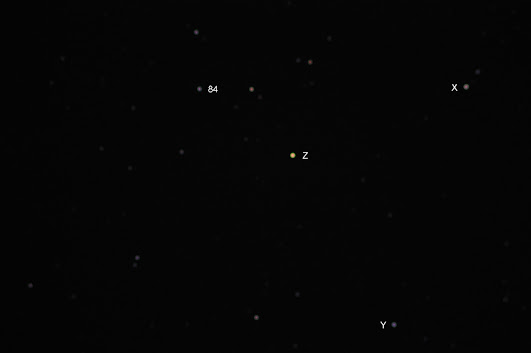In a previous post I attempted to obtain an estimate for the magnitude of Z UMa by using a single 30s exposure taken on my Nikon D90 digital camera mounted at the prime focus of my Celestron NexStar 102mm telescope. This was the frame I took with Z and some other stars marked:-
Using the comparison stars 84, X and Y I was able to determine a magnitude estimate of Z of 7.37, 7.34 and 7.44 respectively. I now wondered if it was possible to use colour information about these comparison stars to try and figure out how to transform these magnitude estimates to a more standardised Johnson V system. I know it isn't much data but I thought it was worth having a go.
If you look at the DSLR observing manual of the AAVSO (it is a bit of a mighty tome, but bear with me) then on page 74 it shows how the response of the DSLR's blue, green and red channels differ from Johnson's B, V and Cousins R. Johnson V is supposed to mimic closely the visual response of the human eye. As you can see, a DSLR green channel has a peak which is similar in wavelength to V but it is narrower in response. Each different make of camera will have a slightly different response as a function of wavelength and this is why it would be an advantage to transform the camera's magnitudes to a more standard V system, if possible.
So how do you do this? If we ignore any extinction considerations for the moment (extinction is how a star's brightness is altered by passing through varying thicknesses of the earth's atmosphere) then we can to first order write that
V(Z) = m(Z) + T * D(B-V)
which is essentially equation 6.12 on page 74 of that manual. Here m(Z) is the magnitude of Z UMa determined using the relative brightnesses of Z and the comparison star measured in the camera. T is a transformation coefficient and D(B-V) is the B-V for Z UMa minus the B-V for the comparison star. B-V is the colour index of a star and simply the Johnson B magnitude minus the Johnson V magnitude.
We have already determined m(Z) above to be 7.368, 7.338 and 7.443 for stars 84, X and Y above, respectively. What we need is an idea of what T is and we need to know the colour indices for Z and the comparisons.
To obtain T we need to plot (V - v) against (B-V) (see equation 6.17 on page 76 of the AAVSO manual) for the comparison stars. V is again the Johnson V magnitude for the comparison star, B-V its colour index and v is an 'instrumental magnitude' given as
v = -2.5 log (brightness of comparsion star measured by the camera)
Hopefully, this should look like a straight line with gradient T. I had to glean the data that I needed from various parts of the internet. For star 84 we have V=8.438 and B-V=0.657. This comes from a plot of Z UMa from the AAVSO. Star X is HIP57820 on the Hipparcos catalogue and V=7.858 (see server3.sky-map.org). B-V=0.97 (see universeguide.com). Star Y is HIP58302 with V=8.375 (see server3.sky-map.org) and B-V=0.42 (see universeguide.com). Using this data and the brightness values for 84, X and Y previously obtained as 25.30, 42.01 and 28.73 respectively I was able to plot V-v against B-V:-
Even though I only have three data points (84, X and Y are indicated) I think that there is a reasonable indication that there is a correlation. The straight line drawn by hand through the data has a gradient of -0.19. Using regression analysis using a calculator gives T = -0.186 which is very close!
Now we can use this to apply a correction to our magnitude estimates for the variable Z. One big problem is that Z is very red in colour and so B-V is large. In fact the B-V for this star may also vary over time and any estimate may not be that accurate. The universeguide.com gives this as B-V = 1.33 for this star.
We find that for stars 84, X and Y the D(B-V) values are 0.673, 0.360 and 0.910 respectively. This gives T*D(B-V) of -0.125, -0.067 and -0.169 using T = -0.186. This makes our V estimates 7.243, 7.271 and 7.274 for Z from these stars. The mean of these values is now V = 7.262 +/- 0.017 whereas previously for uncorrected values it was 7.383 +/- 0.054.
Note that the error has now come down and this is understandable. Some of the variation in the uncorrected estimates must come from the different colours of the comparison stars and this is taken out to a large extent by the transformation.
Looking at the BAAVSS and AAVSO databases for the night of the 2nd/3rd of April there were 11 visual observations of this variable giving 7.118 +/- 0.240. So my V estimate is 0.144 magnitudes fainter but well within the errors. It is expected that even Johnson V and visual estimates will differ for such red stars due to variations in the response of the eye compared to V.
All text and images © Duncan Hale-Sutton 2023







